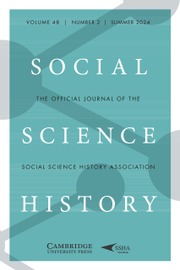Economics of the Second World War: Introduction to the Symposium
Alexander J. Field’s recent book (2022) offers a fresh re-examination of key aspects of the US involvement in World War II and the consequences of that engagement for long-run economic development. While focusing primarily on the supply-side context of the wartime economy, Field argues that manufacturing productivity actually declined during the war. This was due to production being shifted to industries and sectors with little or no prior experience in such manufacturing. Furthermore, Field asserts that the war interrupted the positive strides related to innovations and human capital that had been taking place before the conflict in the 1930s (for a longer review, see Eloranta Reference Eloranta2023).
This book is part of a broader crop of research on the economic history of wars in general, and of the world wars in particular. Building on earlier contributions on the history and significance of conflicts, the volume edited by Mark Harrison (Harrison Reference Harrison1998) on World War II, followed by a volume co-edited with Stephen Broadberry (Broadberry and Harrison Reference Broadberry and Harrison2005) on World War I, brought economic historians back to the study of world wars as extreme examples of warfare and economic dislocation. (On cliometric approaches and traditions in the study of war, see also Eloranta and Hoffman Reference Eloranta, Hoffman, Diebolt and Haupert2024). These volumes engendered renewed interest among scholars in the efficacy of economic warfare, the impact of crises, and the estimation of the war economies’ performance (see also Davis and Engerman Reference Davis and Engerman2006). The revived focus on world wars has also yielded new insights about other conflicts and time periods, such as the Napoleonic wars, another contender for the title of “world war” (O’Brien Reference O’Brien and O’Brien2021; O’Rourke Reference O’Rourke2006). The burgeoning field of the economic history of war has expanded to include many interdisciplinary themes, including state capacity formation and societal fragmentation (see e.g., Dincecco and Prado Reference Dincecco and Prado2012; Hoffman Reference Hoffman2015; Jeppesen et al. Reference Jeppesen, Karoline Bak and Mette Kjær2023; Scherner et al. Reference Scherner, Streb and Tilly2014; Scheve and Stasavage Reference Scheve and Stasavage2010).
Field’s explanation of the wartime productivity decline is novel, and it could be expanded to the study of other war economies and conflicts, i.e., to test whether the US case was an anomaly, which it probably is not. Many other scholars have already explored the demand-side implications of US mobilization and fiscal expansion (see e.g., Bordo and Levy Reference Bordo and Levy2021; Fishback and Jaworski Reference Fishback, Jaworski and Eloranta2016; Ohanian Reference Ohanian1997). In contrast, Field offers a blueprint to study the supply side, using macroeconomic analysis and applicable analytical tools, as well as narratives drawn from a broad swath of business history studies and the history of innovations. He is careful to stress that the primary focus of the book is on the US, although studies of other war economies could be added to the discussion to provide even more depth to the argument – to be fair, he does make comparative points in the book vis-à-vis the German and Japanese economies.
Given that the study of the economic history of war has been thriving in the last 25 years, ranging from books on the world wars to other historical conflicts, their costs as well as their immediate and long-run impacts, this book is an important contribution to that literature, one that hopefully leads to other rejoinders as well. The impact on productivity has not been studied as much as the demand side impact, yet the actual mobilization of the private sector for the war is a pivotal question for modern economies, with deep implications for aggregate economic planning and particular sectors, as can be seen in the conflict between Russia and Ukraine today, with the lesson that resources typically determine the battlefield outcomes in the end, especially during protracted wars. Discussion of this important contribution, first at the 2023 SSHA conference in Washington, D.C., and now in this journal, provides an opportunity to reflect on those findings and possibilities for novel research avenues. The theoretical and empirical dimensions of this book symposium will touch on themes ranging from various fields of history, economics, conflict studies, sociology, and political science. Hugh Rockoff will first outline the book’s contributions and some avenues for critiques, to be followed by reviews by David Mitch, Peter Meyer, and Vincent Geloso. Our discussion will be concluded by some responses and further ideas presented by the author himself, Alexander Field.


